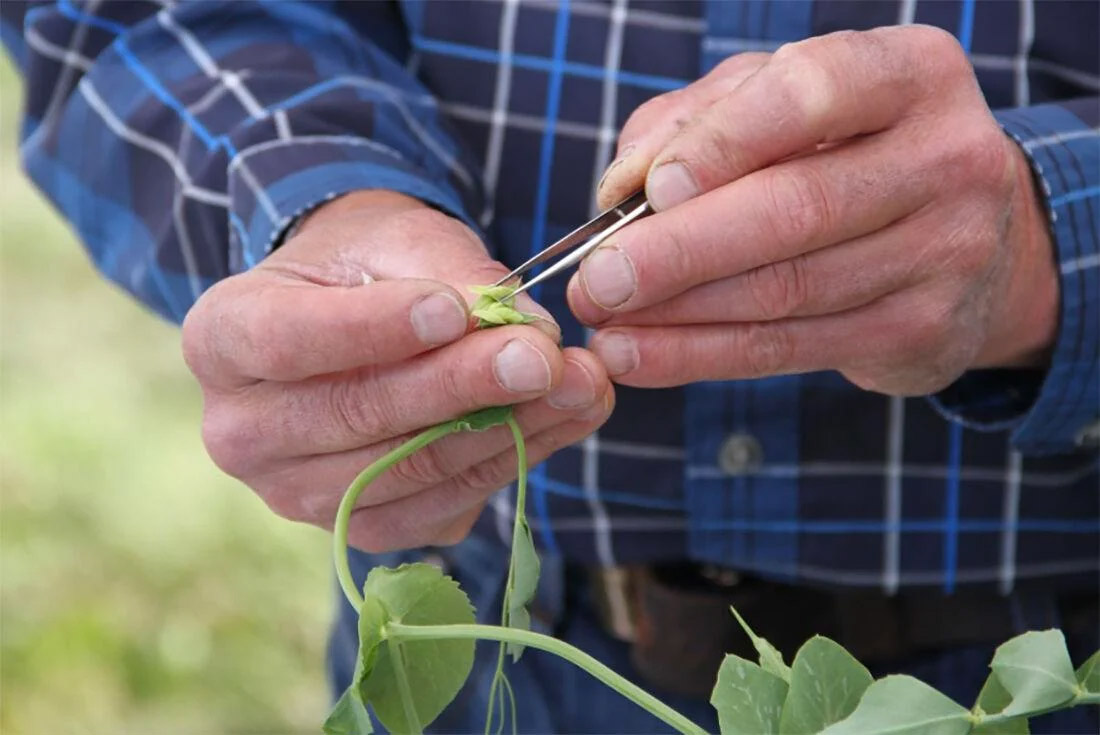By Laura Weingartner
Jim Myers, a professor of vegetable breeding and genetics at the College of Agricultural Sciences at Oregon State University, has a depth of knowledge on plant breeding. Want to know about emasculating pea flowers? He’s your guy. Curious about how to dehybridize a plant variety? Myers can tell you.

Plant breeding expert Jim Myers demonstrates how to emasculate a pea flower at a workshop on plant breeding and seed saving put on by UAF’s Cooperative Extension Service on Aug. 26.
Because of his expertise, Glenna Gannon, assistant professor of sustainable food systems at the University of Alaska Fairbanks Institute of Agriculture, Natural Resources and Extension, invited Myers to host a workshop on plant breeding and seed saving on Aug. 26, at UAF’s Agricultural and Forestry Experiment Station greenhouse headhouse — a horticulturist’s term for the greenhouse’s workspace, and in this case, the classroom.
Members of the Fairbanks Garden Club, UAF students, an Ester Seed Library representative, an apple farmer currently breeding apples and others gathered in the headhouse to hear from Myers and learn how to start breeding and saving seeds from their own plants.
There are various methods breeders can use to improve an existing variety or create an entirely new variety. Mass selection is one of the most common methods of traditional plant breeding. It involves starting with a wide variety of individual plants and, over many years, sowing seeds from the plants with the most desirable traits or simply preventing the worst performers from reproducing.
A breeder can also intentionally cross two parent plants with different desirable traits to find offspring with beneficial traits from both parents. This is possible because within a population of, say, carrots, there is variation between individuals that can be inherited by the offspring.
Desirable traits depend on individual goals and the type of crop. Plant breeders look for traits like high yield, disease resistance, good flavor, weed competitiveness and storage life, to name a few. Most gardeners and farmers in Alaska want a plant that can mature in our short growing season, successfully produce food in long summer days (rather than bolting or never blooming), and taste delicious.
Myers has developed several new vegetable varieties, including the Indigo Rose tomato, a beautiful dark purple variety. This variety has high levels of anthocyanins, an antioxidant responsible for the purple pigment in the skin and important in protecting against sun damage. Anthocyanins aren’t typically found in cultivated tomatoes, but they are found in wild species.
Tomatoes are self-pollinators. Their flowers are considered “perfect,” meaning they have both male and female parts. This allows pollen from the anthers, part of the male reproductive unit, to land on the stigma, part of the female reproductive unit, of the same flower, fertilizing itself. To cross a “selfer,” breeders have to emasculate the flower by removing the anthers before fertilization occurs and then hand-pollinate the stigma using pollen from a different plant. This process looks much harder than it sounds.
To create the Indigo Rose, Myers hand-crossed two different varieties of tomatoes, both with genes from wild species, to create what is called an F1 hybrid. A seed planted from an F1 hybrid won’t breed true, meaning the offspring won’t necessarily look like the parent plant. To “fix the genes” so the plant breeds true to type, Myers had to go through many generations of self-pollination where he selected offspring with desirable traits and didn’t allow poor-quality plants to reproduce. This process can take many years and is referred to as dehybridizing.
Some plants require cross-pollination. To be fertilized naturally, they need pollen from a different plant, and they have all sorts of interesting mechanisms to prevent self-fertilization. In some plants, the male and female reproductive parts are not fertile at the same time. Others have different-sexed flowers on the same individual, or individuals either produce only male or female flowers. In some flowers, the anthers are so far from the stigma that self-fertilization is unlikely. Finally, some molecular processes block selfing from occurring. Plant breeders have figured out ways around these obstacles to create new varieties of potatoes, corn, squash and others.
Myers’ workshop covered much more, including a genetics review, setting up a vigorous trial, evaluating traits, saving seeds and more. One takeaway is that plant breeding is surprisingly complicated because there is so much to learn and every plant is different. Still, participants left excited and Fairbanks may have gained a few more plant breeders.
Laura Weingartner is a science writer for the Institute of Agriculture, Natural Resources and Extension. Contact her at lgweingartner@alaska.edu or 907-474-6009.